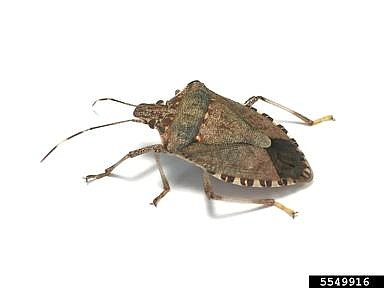Q. Are there any programs coming up about gardening?
A. There is one in Columbia on Saturday, Feb. 29. It is the fourth annual Mid-MO Expo: Small Farm to Backyard Garden and held east of Columbia off I-70 at Battle High School. One can register and view the schedule at midmoexpo.com. It runs from 8:30 a.m. to 3:30 p.m. and the cost is $12 (includes lunch) or $6. For questions, call 573-445-9792 or email [email protected].
Q. I have noticed this stink bug in my house and saw another somewhere else indoors. Seems kind of odd for winter. Anyway, it's kind of large, brown and has these distinctive white and dark brown marks around the edge of its lower back. I can't remember ever seeing it before. Do you know what it is?
A. Oh, that is our dreaded new invasive insect pest, the brown marmorated stink bug. Marmorate means a variegated pattern like marble, and it is kind of an attractive bug (see photo). The species is Halyomorpha halys and has been reported to be in Missouri since 2013. It is originally from Asia, with few natural predators in North America, allowing it to spread quickly. It is expected to become a significant pest as its numbers increase. It is particularly troublesome on fruit trees but has a wide range of plants that it feeds on. The adults seek overwintering sites (houses, barns, storage buildings and dead trees) and it is a huge nuisance to many residents where its populations are high. Look for more information about this insect (unfortunately) for years to come.
Q. I have two perennial plants I bought in the fall and didn't get them planted. So I brought them inside and put them by a cool, sunny window and now have they grown new leaves. They also popped some flowers. Will they be OK when I plant them this spring, and when should I put them out?
A. These sound like they are spring blooming perennials, which need some cold or cool weather and increasing day length to stimulate flowering. The cold of the outdoors hasn't held them back, so they are super early. They should be fine when you plant them. I would wait until we get past the worst of the winter weather (e.g. early March). Cut the flowers off and mulch around the base with about an inch of wood chips or similar. If they get exposed to enough chilly weather, they may bloom again later in the spring. While that may be the only blooms you will get, the new foliage that grows should be fine.
Q. I would like to do some type of planting in my lawn to benefit pollinators, but just don't like the look of all these big shaggy plants like one gets with a prairie. Are there other options?
A. Yes, and this is a good question as now is an ideal time to get started on something like this.
One option is something called an "annual meadow," which is a planting of annual flowers that one establishes each spring and then cuts down the plants or foliage, either going into the winter, or when it becomes unappealing. For this, one needs to select a range of different annual flowers that you like and seed those as a mix and just be happy with what comes up. Typically, shorter flowering plants are desired, but even then, expect flowers as tall as 3-4 feet. This approach has been successfully used in England, but our weather is certainly different here and something like this might look ragged by August.
There are also pollinator lawn mixes available from some companies. These are a mixture of different low growing flowering plants, clovers and some grasses. They can be cut back regularly, if not even managed like a typical lawn but mowed as high as practical. Flower examples for this are sweet alyssum, creeping thyme, baby blue eyes and dwarf poppies. Send me an email if you'd like the name of a company selling this type of seed mix.

